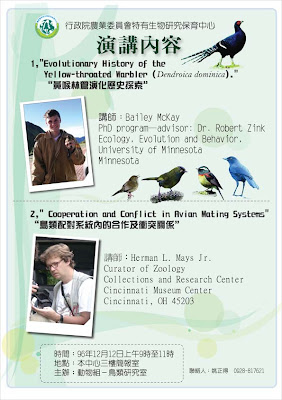Bird banding
It's been a long time coming but I finally have my federal master bird bander permit. Bird banding, or "ringing" as it is known in Europe, involves placing some unique identifier on a bird's leg. People have been banding birds for about four centuries, most typically using metal bands and lengths of chord or string. Recapture of banded birds can provide valuable information about the life history and movements of birds. Along with collecting, bird banding was a central activity in the history of ornithology and it continues to be a major research tool in ornithology today.
Systematic and organized bird banding began in the United States about a century ago and today banding is regulated by the United States Geological Survey's Bird Banding Laboratory. Permission to band birds for individuals is obtained through a master bird banding permit. Application for the master banding permit is a lengthy process and applicants must demonstrate a legitimate scientific and/or educational reason to band birds. Bird banding can be focused on a particular species or done more generally to provide long term distribution and abundance data of local avifauna. Numerous anatomical measurements and other data are recorded for each bird to obtain, among other things, data on plumage and morphological variation, age structure and sex ratio. Once a scientific purpose has been established for a banding program an applicant's training and ability to identify, capture and handle birds is assessed. All applicants are required to provide references from master bander permit holders in order to assess the applicants credentials as a bird bander. Typically most master banding permit holders spent some time as a subpermitee under a master permit holder. If applicants request permission to capture birds with mist nets or collect blood samples additional authorization for these somewhat delicate and difficult practices is required. Currently there are about 2,000 master bander permit holders in the United States and most are from universities and governmental conservation and research agencies. Holding a master banding permit is therefore a great privilege and responsibility and for me an important part of my growth as an ornithologist.
The latest bird banding program at Cincinnati Museum Center (CMC) began this past weekend at Cincinnati Country Day School (CCDS) with CCDS faculty member and CMC adjunct curator Francisco Borrero (see photo above of Francisco removing a bird from a mist net). We had two upper school students show up on a very cold Sunday morning to put up a mist net near a bird feeder on school grounds. So, what was the first bird to be caught under the auspices of my hard won USGS master banding permit? It was a male House Sparrow (Passer domesticus), band number 2291-69601 (see photo left). House sparrows are an abundant species in urban and suburban settings. They are not native to North America but instead introduced from Europe. The first bird recorded in my banding records is not the most exotic of species but a neat little bird none-the-less. Other birds banded on my first official outing as a master bander included blue jay (Cyanocitta cristata), Dark-eyed Junco (Junco hyemalis), European Starling (Sturnus vulgaris) and the Eastern Tufted Titmouse (Baeolophus bicolor, see photo below).

Students seemed to enjoy the chance to handle wild birds (see photo right) and were a big help on processing the birds and recording data. Hopefully bird banding on the campus of CCDS will attract more participation among the CCDS upper and middle school student body. Data gained through bird banding can serve as an excellent introduction to field-based science and we hope students will take full advantage of opportunities at CCDS and CMC and participate in bird banding and other field biology programs. Who knows? Maybe some of the students learning how to catch, measure and band birds in this program will themselves be holders of master banding permits someday?
-END
